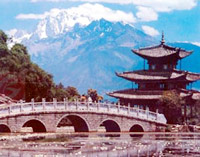
The ancient town of Lijiang stands at an elevation of 2,400 metres in north-western Yunnan Province. It is characterized by many narrow waterways, cobblestone streets, canals, trees and old houses with small shops and cozy guesthouses.
Take a walk away from the main tourist draws, enter narrow streets and climb steep steps up the hill, for a glimpse of the real Lijiang.
If you get lost, follow a stream and you will find yourself in Sifang Square in the centre of the old town.
Here, there are numerous small restaurants serving simple Naxi and Han dishes at bargain prices. There are also many tea shops selling Yunnan tea and some will let you taste the flavour before you buy.
It is cold from dusk till dawn, even in the summer, so it is best to wear something warm. The local people use melted ice water for drinking. You can choose bottled water, which is not so cold.
The Naxi people forbid anyone from throwing rubbish or pouring water into the streams and harming the trees. Also, when visiting the local people, do not sit on the threshold of the homes.
Lijiang's picture-perfect place is Black Dragon Pool. It offers breathtaking views of ponds, pavilions, bridges and the Yulong (Jade Dragon) Snow Mountain in the background.
The Dongba Culture Museum near the Yuquan Park is a great place to admire the famous hieroglyphs and other ritual articles of the Naxis.
Many hotels and inns offer bikes for hire. Within an hour or two, you can cycle out of Lijiang and make your way through traditional Naxi villages that are not on the tourist trail. You will not find any tourist facilities here: no bars, restaurants or shops, just family units living in communities working on land.
About 7 kilometres from Lijiang lies the secluded Suhe Village. Leather processing, bamboo wares and educational facilities that date back to ancient times make it an interesting stop.
The Yulong Snow Mountain is located 35 kilometres from Lijiang and the fastest way to get there is by taxi. From there, grab a chairlift to a height of 4,506 metres to the mountains. Or, you can walk through the forests and reach Yunshanping (Fir Flatland) or Maoniuping (Yak Flatland) from where you can take fantastic pictures.
These two places are famed as the sites where young Naxi lovers sang and danced before committing suicide over parental objections to their relationship. Such tragedies, which peaked in the Qing Dynasty (1644-1911), seldom happen anymore.
The Dongba Park near the Yufeng Temple on the southern slope of the Yulong Snow Mountain is also worth a visit. Its architecture conforms to Naxi mythology and Dongba shamans often perform various rituals here.
Lashihai Lake, 8 kilometres west of Lijiang, has emerged as a nature reserve for some 30,000 birds of 57 species. From the serene alpine lake, you can trace several streams to their origin. For example, the Meiquan Stream originates in the Zimei Pool whose crystal-clear waters can be viewed 6 metres deep.
There are buses in Lijiang going to Lugu Lake, some 200 kilometres away. You can live with a local Mosuo family there and get a glimpse of the interesting customs of their matriarchal society.
(China Daily March 4, 2006)
|

